Purple Brittlegill
This imaginatively named mushroom belongs to a great family for novice foragers to learn about. They are very common and it is easy to distinguish between the poisonous and edibles within the genus Russula.
| Mushroom Type | |
| Common Names | Purple Brittlegill (EN), Blackish Purple Russula, Tegyll Brau Porffor (CY), Gołąbek Ciemnopurpurowy (PL), Feketésvörös Galambgomba (HU) |
| Scientific Name | Russula undulata |
| Synonyms | Russula atropurpurea |
| Season Start | Aug |
| Season End | Nov |
| Average Mushroom height (CM) | 6 |
| Average Cap width (CM) | 10 |
Cap
It is a dark red wine colour with purple to almost black in the middle. Starting convex, flattening with a depression in the middle.
Possible Confusion
Other red or purple Russulas (see the Beechwood Sickener). A good test for Russulas is the taste test, if a tiny amount is placed on the tongue and chewed a burn like chilli means the mushroom is poisonous, a pleasant mushroomy taste means it is edible. This test should only be attempted when you are certain you have a mushroom from the genus Russula.
This mushroom can be peppery on the tongue but is edible when cooked so care should be taken when identifying this mushroom for consumption.
Spore Print
Off white. Subglobose to globose.
Taste / Smell
Smell is sweet and fruity. Taste can be fairly mild but more often moderately hot and chilli like, in particular in the gills. The taste test should only be done when you’re certain that you have a Russula and the chewed bits should be spat out. This mushroom must be cooked before consumption.
Frequency
Common.
Other Facts
The genus Russula split from other mushrooms, evolutionarily, many years ago and have round cells instead of elongated cells like most living organisms, this gives Russulas the common name Brittlegills as the cells make the mushroom brittle.



 (50 votes, average: 3.60 out of 5)
(50 votes, average: 3.60 out of 5)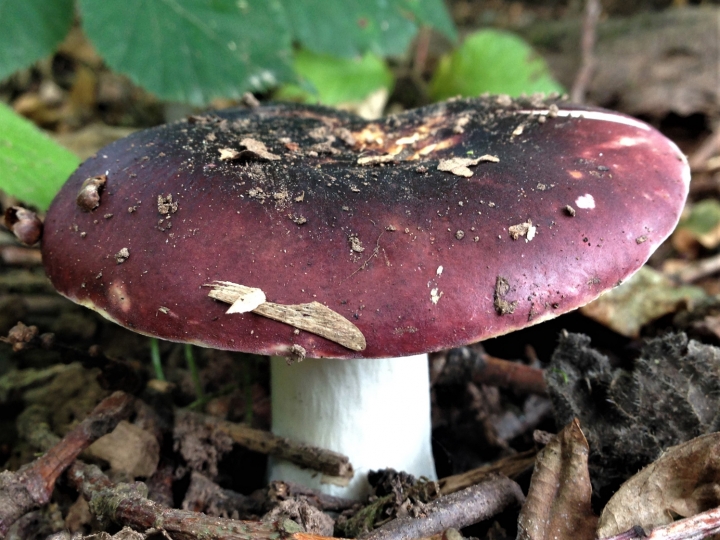
















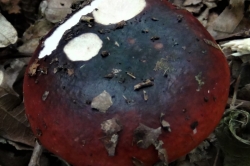
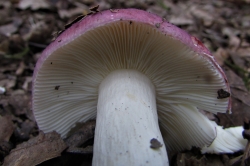
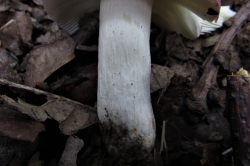
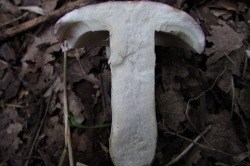
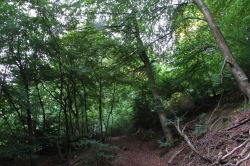





14 comments for Purple Brittlegill
Hi there,
I picked this purple Russula but the stems are not white but a but purpleish, is it the same one or it is inedible one.
Please advise
The Blackish Purple Russula should have a white stem, there are similar species with a purple tinge to the stem such as Russula sardonia, there are no purple stemmed ones that I eat.
Tried some of these today as there were absolutely tons in a local wood where I and the local squirrels have been enjoying a strange but incredibly satisfying combination of dark ceps and summer boletes and it seems like the ceps I had lots of over the last few weeks are unfortunately over already. (but I’m still hoping for another flush?!) Anyway I used a method of cleaning I found elsewhere that requires a poaching/parboiling step. I don’t know if it was this step that was to blame but upon subsequent frying I was not impressed. Not much flesh and not particularly flavourful. Might be okay in a mixed mushroom soup or something but not brilliant for breakfast!
Sorry, must’ve hit reply by accident!
Just found some beautiful ‘white stem’ samples in my local wood.. easy to distinguish from any other russula. Enjoying the clean up after the forage.. many thanks to Wild Foods UK for my copy of there book I have with me everywhere I go 🙂 love every moment of life with nature nurturing our souls! Bless
I too have found purple stemmed and purple capped russula’s. Even with the caps blackening in the centre. Growing in the same place as Blackish Purple Russulas. I came to the conclusion that they were in fact “bloody Brittlegills” which are similar in almost all respects other than this stem colouring. Be aware as these are poisonous.
Perhaps an additional inclusion to the possible confusion notes. The stem colour is a simple enough point to flag.
Hi just looking for some clarification regarding Blackish Purple Russula and the raw taste test. Does chilli like heat indicate that the actual mushroom you are tasting is poisonous, or is this acceptable and will be will it be edible when sufficiently cooked?
Thanks.
The safe way to consume Russulas is to only eat any that have no chilli or pepper like heat, however, some that have heat are edible, you have to be confident with your IDs if you go down that path. They do not become safe after cooking but the most poisonous Russula in the UK will only cause you to vomit back up the mushrooms you have eaten.
I took a small bite out of a raw one and boy was it spicy. I did swallow but it was a little bit.
I saw a small crop of these around a year ago and have been trying to figure out what it was for ages, finally found it but I’m not sure they’re gonna pop up again. Did manage to get an idea of their habitat which is always good to know
Is the cap sticky, gathering on its surface all sorts of debris, bits of hay, grass,etc
All the ones I found were sticky on the top, even the very young ones, small and cute.
A lot of Brittlegills often are, quite common to see them covered in debris, but not always thankfully.
Hi can you please clarify about the taste?
We stumbled upon a large group of mushrooms, under a pine tree in January, that conform to all of these characteristics.
I took a small piece and chewed in my mouth: It definitely had heat!
I remembered that Russulas that have heat are toxic but now I am reading it again and notice “peppery” is acceptable?
Also, in the comments, it seems that heat does not necessarily condemn this mushroom?
I looked at the Beechwood Sickener and the Sickener and, visually, the mushrooms we found didn’t look like those… But they did taste hot…
Would appreciate any extra info 🙂
The best thing to do is stick to our advise and avoid any hot or peppery Russula unless you can positively identify the mushroom. This will keep you 100% safe. There are over 200 Russula found in the UK and some, but not all, of the peppery tasting (slightly peppery, not hot like chilli) Russula are edible but you need to know the mushrooms before consuming them. The Sickener is one of the hottest and most toxic Russula in the UK and even it will only cause you to bring the mushroom back up and anything else in your stomach. They used to be used as emetics in hospitals.